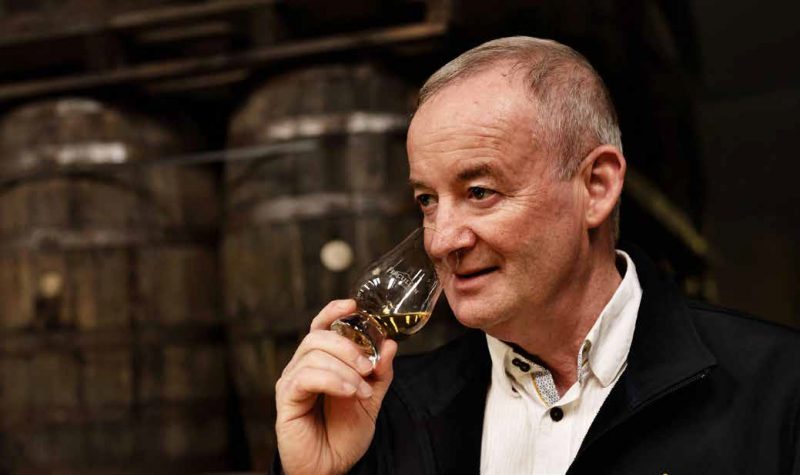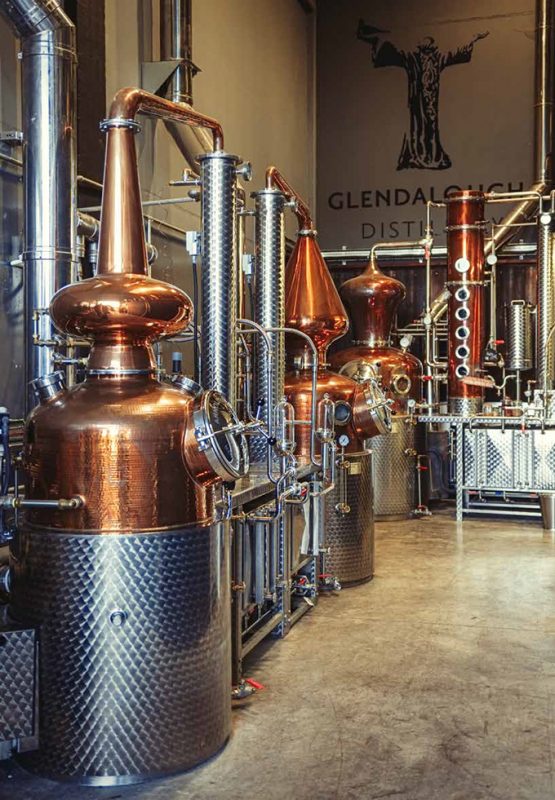This article originally appeared in the Winter 2021/2022 print issue of Quench Magazine.
An rud nach leigheasann im ná uisce beatha níl aon leigheas air.
It’s an ancient Gaelic proverb, the meaning of which translates to: What butter or whiskey does not cure cannot be cured. “These were the two best things an Irish home could have in the larder,” informs Santina Kennedy, the in-house Food Historian at Powerscourt Distillery located just south of Dublin. The phrase shows not only the reverence the Irish have for their local dairy products and, of course, their whiskey, but it also hints at something that has always existed but is now being more fully appreciated: the combination and intersection of Irish food, drink, and culture.
One of the oldest European spirits (the word whisk(e)y itself being derived from the Gaelic uisce beatha or water of life), Irish whiskey was once the most popular spirit in the world. Though falling rather dramatically from its lofty position in the spirits hierarchy, the popularity of Ireland’s native spirit has rebounded significantly.
“Irish whiskey stands out due to its rich and vibrant history dating all the way back to the 12th Century, as one of Europe’s earliest distilled drinks,” confirms Jack Teeling of Dublin’s Teeling Distillery. “During the 17th and 18th centuries, Irish whiskey flourished and was to be found across the four corners of the globe, with Dublin creating the most flavoursome and popular whiskies of the time.”
“It was the British Empire that really sparked the success of Irish whiskey,” notes Noel Sweeney, Powerscourt Master Distiller. “It spread throughout the commonwealth and developed strong markets in America, India – even Africa – wherever the British took their drink. The industry boomed until about 1905, then started to go into decline for various reasons.”
The bigger they are, the harder they fall, or so the saying goes. The 20th century certainly tripped Ireland’s whiskey giant. Disruptive economic and political factors – wars, independence, punitive taxes, prohibition in the United States and the temperance movement at home – brought the industry to its knees. The close to 30 operational distilleries in 1887 shrank to but two by the mid-1970s. Luckily, a complete slide into the abyss didn’t happen, and the latter part of the 1980s saw the beginning of a slow but steady resurgence. Today, the number of working distilleries has returned to, and likely exceeded, that of the country’s distilling glory days.
Bernard Walsh, Managing Director of Walsh Whiskey, reckons that the “Big Bang” phase of distillery expansion has likely cooled. “We are now in the early stages of those new distilleries settling down to produce a full suite of Irish whiskey styles.”
In a dramatic example of what goes around, comes around, Irish Whiskey Global: Irish Whiskey International Trade Report 2021 notes that “Irish whiskey was officially the fastest growing spirits category in the world over the past decade, with 140% growth in sales from 2010 to 2020.” In fact, it’s estimated that by 2025, sales of Irish whiskey in the United States will surpass that of scotch, its main competitor. While the COVID-19 pandemic had a slight negative impact, global sales of Irish whiskey in pre-COVID February 2020 broke the 12 million case mark. The Report also revealed that “Across all major markets, 2020 saw a continuation in the trend towards premium-and-above Irish whiskey, with strong growth at higher price points expected in coming years.”

Not only are the number of distilleries returning to pre-decline levels, a newer style of Irish whiskey is emerging based – somewhat ironically – on a much older style.
Until the introduction of the Coffey or continuous still, Irish whiskeys were crafted using copper pot stills. The Coffey still, which allowed for spirits to be made continuously and comparatively cheaply, was not exactly welcomed by most Irish distillers, who went as far as to declare that any spirit coming out of the new contraption shouldn’t even be called whiskey.
Nonetheless, the use of the Coffey still eventually became accepted. One of the offshoots was a style of Irish whiskey that was lighter in body, less assertive in flavour, and less complex. The newer breed of distillers are looking for a bit of a return to the original style.
“I was interested in what made Irish whiskey so interesting back in the 1800s,” Walsh says. “Traditional Irish whiskies were a blend of single pot still [a distinctive style of whiskey unique to Ireland that uses both malted and unmalted barley in the mash] and single malt whiskies, without the inclusion of column-distilled grain spirits. In the 1900s, this more assertive style largely disappeared. We wanted to push forward by going back to what Irish whiskey had historically – and originally – been like.”
Experimentation with different wood types for maturation and finishing is also becoming standard practise for both new and established distillers. Katherine Condon, Distiller at Irish Distillers (producer of the Jameson brand, among others) reports that her company’s commitment to wood experimentation and maturation has taken it around the world in search of exciting new varieties.
“One example is the new limited-edition release Method and Madness single pot still Irish whiskey finished in virgin mulberry wood.” A world first for Irish whiskey, this release features spirit finished in white mulberry wood felled from central Hungary. “The wood is harvested and air-dried for two years at the Kádár sawmills in Tokaj before being transferred to a cooperage in Budapest. The relatively high porosity and medium toasting [of the wood] impart elevated flavours of wood spices and enhanced toffee sweetness to the whiskey.”
Walsh reports that finishes in his Writers’ Tears whiskey stable include “Seaweed IPA Cask Finish,” “Marsala Cask Finish,” and “Mizunara Japanese Cask Finish.” He also says that Writers’ Tears has another first for Irish whiskey involving a unique collaboration in Canada on route that is set to be launched this fall in Toronto.
Teeling says his distiller uses over 100 different varieties of casks. Irish law says the casks must be made of wood. It doesn’t stipulate the type. Chestnut? Acacia? Amburana? Knock yourself out. Not surprisingly, a return to the use of native Irish oak is being tried by a few distillers.
“Before the term Emerald Isle became synonymous with Ireland, it was actually called the Wooded Isle because 90 per cent of the island used to be covered in forest,” Donal O’Gallachoir of Glendalough Distillery explains. “However, the once plentiful indigenous Irish Oak was almost completely cleared away. The only places you find it now is on (the grounds of) old manor houses and in the more mountainous areas. The original oak for aging Irish whiskey would have likely been our own, and as we went around the world looking for various finishing casks, it dawned on us to take a look at what would have been used historically.”
As O’Gallachoir notes, Irish oak isn’t easy to come by (largely due, Sweeney quips, to the past British penchant for chopping it all down to build warships), and his distillery goes to some length to ensure sustainable harvesting.
“We harvest the oak trees in a very sustainable way,” O’Gallachoir reveals. “For every one tree felled, seven more are planted. The type of tree we use – Dair Ghalda – is a rare and unique native variety that’s very porous, and fast growing due to the climate in Ireland, and it lends flavours like sticky toffee and black molasses to the matured whiskey; a whiskey that has a character like nothing else out there.”
With the ongoing interest in Irish whiskey has come a corresponding interest in whiskey tourism, as well as a desire to explore the ways whiskey fits into Irish culture, gastronomy and hospitality.

“The majority of Irish people throughout Irish history had a very hard life,” Kennedy reveals, “and a little drop of something to take the edge off was always welcome. Whiskey also fuelled a lot of our literary traditions, poetic traditions, music traditions…and our sense of fun and hospitality. In any case, for a lot of Irish people, whiskey was almost a necessity to get through the hardships of life.”
Kennedy also explains that whiskey was so ingrained into Irish culture and tradition that there was literally nothing that could come between the Irish and their drink. Even at the height of the temperance movement there was a place for whiskey. “Everyone, no matter how influenced by the temperance movement they may have been, recognized that a wee drop of something was a part of Irish hospitality, particularly for special visitors…the Catholic priest, for example. It was still perceived as something special. You might have come in for a cup of tea, but it wouldn’t be long before a bottle of whiskey came out.” She also points out that St. Patrick’s Day happens to fall in the middle of Lent. So even though most people would have stopped drinking for that period, you were effectively allowed to give up Lent on St. Patrick’s Day and indulge in a nip or three.
Whiskey was synonymous with wakes – both of the traditional sort and what was called the American Wake. When a son left for America, that was ultimately the last he’d see of his family. This sort of wake would go on for a few days and those attending would typically have been well lubricated with whiskey.
Of course part of the Irish tradition of hospitality maintains that your guests are fed and not just watered. Gastronomy might not come immediately to mind when you think of Ireland, but Kennedy thinks this is changing as more people discover the island’s bounty.
“I’m really proud of our food culture that isn’t celebrated enough,” Kennedy confesses. “The pairing of local food with our whiskey speaks to our inherent hospitality that dates back to the time when hospitality was written right into law. When a stranger arrived at your door you made sure they were given food and drink. I think this has remained an inherent part of who we are – and why people come to Ireland.”
Kennedy points to the superb raw materials at the heart of Irish cuisine. “We have the best dairy produce in the world; we have a fantastic culture of producing artisanal, family-farm produced food items.” All of which can work with Irish whiskies.
“There are some very natural pairings: chocolate – especially that with nuts and citrus. But this is a bit limited. So, with an eye to Irish history, we are looking at the foods that would have been produced in the past – creamy cheeses where the fat content works with the alcohol component in whiskey.”
Speaking of alcohol, one of the keys to making food and whiskey work together should be dead obvious, but it’s often overlooked. “The legislation states that Irish whiskey can only be bottled above 40 per cent alcohol, but that doesn’t mean that’s the way you should drink it,” Sweeney cautions. “Especially with food pairing; you can dilute it down a bit to allow the flavours to best mingle with the food.”
No matter how dynamic, an industry can’t grow without people to harness and direct that growth. Renewed curiosity in distilling by Ireland’s younger generation will be instrumental in the renaissance of the Irish whiskey industry. As Walsh colourfully puts it: “Youth will, and should, have its fling! Given the many decades that Irish whiskey was in the doldrums, it is both inevitable and essential that there is an influx of younger generations to fill the void and seek out their ‘fortunes’ in a sector that is rebuilding towards the status it held 100 years ago. There is plenty of room for both young and new masters in the Irish whiskey scene. We need the Banksys and Lady Gagas of the new generation to join those of us who are closer to the Damien Hirst and Pink Floyd phases of our careers. With that sort of community we can safely say that the best is yet to come for Irish whiskey!”

Jameson Black Barrel
(40%, 750ml, $50)
Sporting a fragrant nose of rich charred oak (it’s aged in double-charred casks), dried fruit, toasted hazelnut, pear, vanilla, creme brûlé, the flavour profile of this assertive dram leans toward dried fruit, vanilla, mild smoke, clove, and brown butter, all of which segue into a long, warm, mildly spicy finish.
Powerscourt Fercullen AGED 8 Years
(40%, 700ml, $62)
In spite of a certain trend away from them, Master Distiller Noel Sweeney feels that age statements on whiskeys give the consumer a certain degree of authenticity by letting them know exactly what they are getting. Power-scourt Distillery’s Fercullen Aged 8 Years mar-ries aged malt and grain whiskeys. It delivers a crisp, fresh nose of citrus compote, vanilla bean, white pepper, and toasted grain. A dash of cracked pepper on the palate accentuates the citrus fruit, sweet vanilla oak, and nutty, toasted barley flavours. Some peppery spice sticks around on the lively, memorable finish.
Roe & Co. Blended Irish Whiskey
(45%, 750ml, $50)
This blend of grain and malt whiskeys was crafted by Roe & Co.’s Master Blender, with input from a group of five bartenders. Aromat-ic nuances suggest pear, vanilla, lemon rind, nougat, marzipan, and toasty oak. Mid-weight in the palate, it delivers a warm, smooth, at-tack that leads into flavours hinting at charred oak, with a touch of baking spice/white pepper, vanilla, and pear.
Teeling Small Batch Irish Whiskey
(46%, 750ml, $52)
Teeling’s Small Batch is aged in ex-bourbon casks before being transferred to ones that used to hold Central American rum for an ad-ditional 12 months. Sultana, caramel, vanilla, marmalade, cocoa powder, and fruitcake all mingle in a quite complex aromatic collage. There are distinctive fruity notes on the rich, full palate, with nutmeg, vanilla, and some slightly charred oak notes as well. It finishes with some floral, caramel, savoury notes.
Writers’ Tears Double Oak Irish Whiskey
(46%, 700ml, $63)
This triple pot still-distilled whiskey is aged in a combination of American ex-bourbon and French ex-cognac casks, resulting in expressive aromatics. Very intense, with ripe pear notes dominating, there are also suggestions of vanilla, toffee, baked apple, baking spice and traces of malted barley. Silky and round in the mouth, it boasts complex, ripe fruit and warm spice notes. Its long finish features hints of toasted nuts, and just a dash of smoke.
Tod Stewart has been a beverage alcohol industry professional for close to 40 years. He is an award-winning journalist and published author who has worked as a consultant, trainer, and educator to the hospitality industry, the Ontario wine industry, and the beverage alcohol trade. He has traveled and written extensively about international food, drink, culture, and history. His book, Where The Spirits Moved Me is currently available on Amazon and Apple. His cocktail of choice is a classic martini and the best concert he ever attended was Jethro Tull in 1978.

No Bushmills coverage?